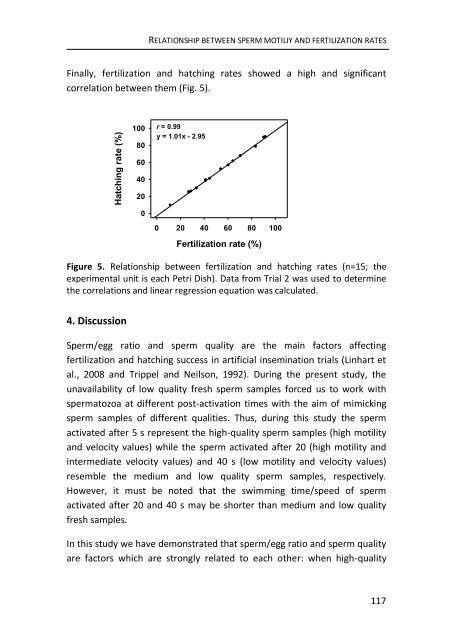chapter 3 - RiuNet
chapter 3 - RiuNet
chapter 3 - RiuNet
You also want an ePaper? Increase the reach of your titles
YUMPU automatically turns print PDFs into web optimized ePapers that Google loves.
RELATIONSHIP BETWEEN SPERM MOTILIY AND FERTILIZATION RATES<br />
Finally, fertilization and hatching rates showed a high and significant<br />
correlation between them (Fig. 5).<br />
Hatching rate (%)<br />
100<br />
80<br />
60<br />
40<br />
20<br />
0<br />
r = 0.99<br />
y = 1.01x - 2.95<br />
0 20 40 60 80 100<br />
Fertilization rate (%)<br />
Figure 5. Relationship between fertilization and hatching rates (n=15; the<br />
experimental unit is each Petri Dish). Data from Trial 2 was used to determine<br />
the correlations and linear regression equation was calculated.<br />
4. Discussion<br />
Sperm/egg ratio and sperm quality are the main factors affecting<br />
fertilization and hatching success in artificial insemination trials (Linhart et<br />
al., 2008 and Trippel and Neilson, 1992). During the present study, the<br />
unavailability of low quality fresh sperm samples forced us to work with<br />
spermatozoa at different post-activation times with the aim of mimicking<br />
sperm samples of different qualities. Thus, during this study the sperm<br />
activated after 5 s represent the high-quality sperm samples (high motility<br />
and velocity values) while the sperm activated after 20 (high motility and<br />
intermediate velocity values) and 40 s (low motility and velocity values)<br />
resemble the medium and low quality sperm samples, respectively.<br />
However, it must be noted that the swimming time/speed of sperm<br />
activated after 20 and 40 s may be shorter than medium and low quality<br />
fresh samples.<br />
In this study we have demonstrated that sperm/egg ratio and sperm quality<br />
are factors which are strongly related to each other: when high-quality<br />
117
















